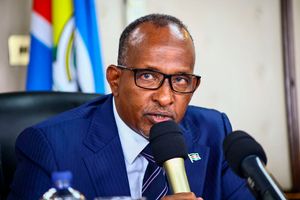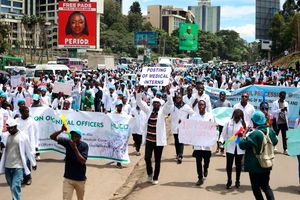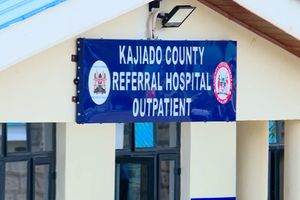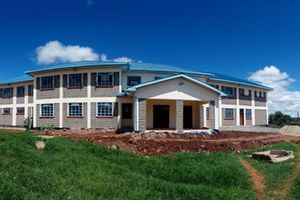
Kenya could lose a significant portion of its nursing workforce to high-income countries by 2030, driven by low pay and poor working conditions.
As we walk into one of Nairobi’s largest government-run maternity hospitals, we find a neonatal nurse seated under a tree, her eyes vacant, her posture heavy with despair. She stares into space, as if willing herself to disappear.
Moments later, we learn why.
She has just lost a newborn baby, a life she had fought for, tirelessly, for hours to save.

Nurses who are working under the UHC Programme demonstrate outside Parliament Buildings in Nairobi on March 11, 2025.
“Did you know neonatal nurses are considered the lowest cadre in the healthcare profession?” she begins, her voice barely above a whisper. “Yet we fight day and night, often with no resources, just to keep newborns alive.”
Her eyes well up, but she doesn't break.
“I earn Sh10,000. That’s not enough to pay my rent. I walk to work, even in the rain, even at night after long shifts. There are no diapers, no formula, nothing these preterm babies need to survive. We dig into our own pockets to help them see another day.”
Her grief is raw, but her routine remains unchanged.
“When a baby dies in my arms, I have to move on like a robot — there’s no time to mourn. In the neonatal unit, every second matters. But in my six years here, no one has ever asked me how I’m doing. I am human too.”
"Due to the sensitive nature of the issues she shared, she requested anonymity and disclosed that she has been quietly applying for nursing jobs in the United States.

Nurses who are working under the UHC Programme demonstrate outside Parliament Buildings in Nairobi on March 11, 2025.
“I have friends who moved there. They tell me the grass is greener.”
And she’s not alone.
According to the 2025 State of the World’s Nursing Report by the World Health Organization (WHO), the International Council of Nurses (ICN), and partners, Kenya is at serious risk of a nurse exodus.
The report shows that while the nurse-to-population ratio has improved, from 8.3 per 10,000 in 2013 to 22.7 per 10,000 in 2025, the country still falls short of the WHO’s recommended threshold of 25 per 10,000. Worse still, the improvements may be short-lived.
The global health body warns that unless urgent interventions are made, Kenya could lose a significant portion of its nursing workforce to high-income countries by 2030, driven by low pay and poor working conditions.

Universal Health Coverage (UHC) nurses from Coast counties demonstrate on the streets to demand better terms of employment.
Currently, public hospital nurses earn an average of Sh29,841 ($231), an amount many describe as “too meagre for the burden we carry.”
As Kenya marks World Nurses Day, this neonatal nurse's story is a sobering reminder: behind every saved life, there’s a caregiver silently breaking down. This is the daily struggle many nurses face as they strive to deliver quality healthcare to Kenyans.
As of 2025, Kenya has 125,499 nurses compared to 2013 when it had 40,000, which means in the last 10 years the government has hired 85,499 more nurses and that the country has been graduating an average of 1,070 nurses per year.
“Inequities in the global nursing workforce leave many of the world’s population without access to essential health services, which could threaten progress towards universal health coverage (UHC), global health security and the health-related development goals,” the global health regulator says adding that globally the nursing workforce has grown from 27.9 million in 2018 to 29.8 million in 2023 but wide disparities in the availability of nurses remain across regions and countries.
WHO also cites that no nurse in the country reported having a care package for mental well-being, 73 per cent are female and 27 per cent are male, while 7.7 per cent are foreign trained and 0.2 per cent are foreign born.
“The evidence indicates global progress in reducing the nursing workforce shortage- from 6.2 million in 2020 to 5.8 million in 2023, with a projection to decline to 4.1 million by 2030.

Nurses under the Kenya National Union of Nurses (KNUN) demonstrate on the streets of Kisumu on January 14, 2024.
But, the overall progress still masks deep regional disparities: approximately 78 per cent of the world’s nurses are concentrated in countries representing just 49 per cent of the global population,” warns the report.
According to the report, low- and middle-income countries are facing challenges in graduating, employing, and retaining nurses in the health system and will need to raise domestic investments to create and sustain jobs.
In parallel, high-income countries need to be prepared to manage high levels of retiring nurses and review their reliance on foreign-trained nurses, strengthening bilateral agreements with the countries they recruit from.
While dissecting the findings of the report, acting WHO Regional Director for Africa, Dr Chikwe Ihekweazu, said that it offers a clear and urgent call to action.
In the African Region, he pointed out, recent investments in nursing education and training are yielding results.
“The number of nurses has nearly doubled, from 900,000 in 2018 to 1.7 million in 2023, increasing the nurse-to-population ratio from 8.7 to 14.1 per 1000 000 people.
Yet this remains one of the lowest ratios globally, and more than tenfold lower than in high-income countries,” he observed noting that nurses account for 66% of the region’s projected shortfall of 6.1 million health workers by 2030.
“This shortage limits access to essential services, from maternal and child health to chronic disease care, and slows progress towards universal health coverage.
Nurses are more than caregivers, they are educators, innovators and frontline responders, often working in the most remote, under-resourced or crisis-affected areas,” further observed while urging African governments to commit to building a future in which nurses are trained, protected, respected and empowered to lead.








